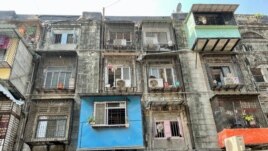02 April 2022
For Shailesh Kambli, a childhood dream is about to become reality. The 40-year-old Indian man lives in a 15-square-meter, one-room home in India's financial capital, Mumbai. It would not be too small -- if he lived alone.
But Kambli's parents, brother and his brother's wife all live there, too. Kambli represents the third generation of his family to live in the small, crowded home contained in an old building in much disrepair.
He said he always dreamed of living in a modern building.

Under a redevelopment project, high rise buildings will replace these damaged, century-old tenements called BDD Chawls in the heart of Mumbai and give the residents new, larger homes. (Anjana Pasricha/VOA)
"Whenever I went out, I wanted to own a house, however tiny, in one these buildings," Kambli recalls. "I even told my uncle that one day I will live in such a place."
Land far more valuable than buildings
Thousands of other Indian families live in similar spaces in an area of Mumbai called BDD Chawls. The 37-hectare area is dense with people and with tenements that were built about one hundred years ago.
Real estate in the area, however, is among the costliest in the world.
All around the BDD Chawls, business and residential development has expanded quickly in recent years. Mumbai is home to more than 20 million people.
Now, Kambli and others dreaming of new, better homes have a chance to see that dream come true.
Under a massive $2 billion redevelopment project, the 16,000 tenements like the one Kambli lives in will be destroyed and replaced with modern, high-rise buildings.
The project is part of major plans that Mumbai has long sought with limited success: to clear costly land of old, damaged buildings and replace them with tall buildings that include homes, offices and large market centers.
Some city planners, however, have raised concerns about the project and the pressure it could add to the city's weak infrastructure.
BDD built before India's independence
Britain built the BDD Chawls during its colonial rule of India. It needed the rooms to house migrant cotton mill workers.
Inside most homes, a large cloth piece separates the counter at one end that serves as a kitchen from the rest of the space that serves as both a bedroom and a living room. Televisions are put over the bed or in a corner. Two bathrooms serve 20 rooms. The occupants pay the government a small amount every month for the homes.
Older people often spend their day in the long passageway that leads to the rooms or just outside on the grounds. They hang their wash to dry, or look after children when their parents go to work. There is a sense of community in the tenements, some residents say.
Lately, some residents have been visiting a model home in a nearby building to get an idea of what the future may look like for them.
"I don't know when my turn will come. It may still take years," said 55-year-old Bhagwan Sawant. He pointed to the kitchen and other parts of the model home. "It will be great to have a modern" home, he said.
The new complexes will also have a hospital, schools, and activity centers for sports. "The work has started on the first building and it will be ready in three years," said Prashant Dhatrak, the top engineer of the project. "But the entire development will take seven years."
It took more than 20 years to launch the project after it was first proposed. Some experts are warning that the huge project is moving too fast.
More private space, less community?
"Redevelopment is necessary, but rebuilding has to be done in a sustainable and environmentally friendly manner," said Sulakshana Mahajan. She was a member of the former Mumbai Transformation Support Unit, a state government policy group set up in 2005. It was involved in earlier proposals for the redevelopment of the tenements and shut down in 2019.
She said the early plans did not aim to increase density but to better house the existing residents. That is no longer the case, she said.
"Open spaces available per person will be drastically shrunk and distance between buildings is too little." Mahajan said. She argued that the project could create too much demand on city services such as water supply, waste removal and transportation.
In the BDD Chawls, most residents are more happy about the project than they are worried about it. There is a growing sense, however, that the redevelopment will end the communal way of life they have now.
"Here, I never have to worry about my mother. All of us work, but know that someone will look after her if she is unwell," said Kambli. But, when they close the door of their new home, he added, "no one will know what is happening inside."
Nearby, resident Ranjana Gurav laughs. "You just give one shout here and everyone gathers," she said. "When there are marriages or celebrations or a problem, we are all there to help each other."
I'm Caty Weaver. I'm Dan Novak.
Anjana Pasricha reported this story for VOA News. Caty Weaver adapted it for Learning English.
Write to us in the Comments Section or visit us on Facebook
_______________________________________________________________
Words in This Story
tiny -adj. very small
residential-adj. of or relating to a place where people live
tenement -n. a building divided into separate apartments for rent
real estate -n. property in buildings and land
infrastructure -n. the system of public works of a country, state, or region
sustainable -adj. of, relating to, or being a method of harvesting or using a resource so that the resource is not used up or permanently damaged
drastically -adv. severely or seriously